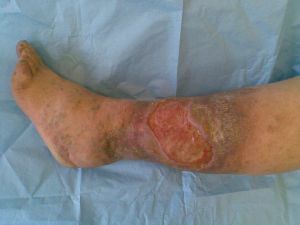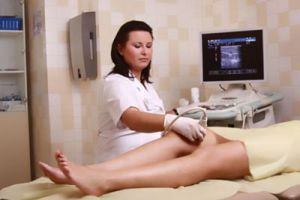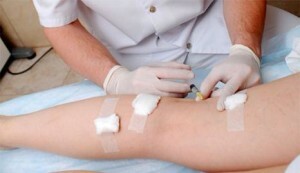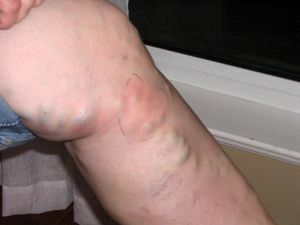 Venous insufficiency of the lower extremities - is a set of changes , associated with the operation of the veins of the legs and the disturbed outflow of blood in them.
Venous insufficiency of the lower extremities - is a set of changes , associated with the operation of the veins of the legs and the disturbed outflow of blood in them.
Most often affects people who are inactive or not healthy way of life, people of advanced age, although, lately, it is more common in young people.
The normal life of any living being requires blood circulation. Blood carries many useful substances( salt, oxygen, hormones) from one organ to another.
The circulatory system consists of "pump" - the heart and "channels" - vessels , whose purpose is to deliver blood, and with it useful elements, to all organs and tissues. Vessels include arteries, capillaries and veins.
Veins are the vessels in the body through which blood moves to the heart, and through which blood is supplied through the blood to the organs and tissues.
Content
- VNNK varices
- Reasons pathological condition
- Comorbidities
- disease Classification
- Symptoms and signs VNNK
- Consultation
- Diagnostic techniques of modern medicine
- complex therapeutic measures
- Conservative treatment
- Surgery
- Additional recommendations
- Complications of the disease
- Prevention
- Video:What can tell the inflamed veins of the legs
VNKK and varicose
Varicose veinshas obvious and easily observed causes, more often of a cosmetic nature, and the combination of symptoms associated with varicose veins is called venous insufficiency.
Venous insufficiency( formed only in veins under the skin), entails varicose veins, and varicose complicates the course of venous insufficiency.
Treatment and prevention of these diseases are very different, although they have much in common.
Causes of a pathological condition
Causes of ailment are very diverse and often combine into a whole complex.
The causes of HAS may be - heredity, difficult pregnancy, overweight, lack of physical activity, physical labor associated with weight lifting, prolonged work in standing or sitting position, that is, when there is a violation of normal blood flow fromlower limbs to the heart.
The process of the onset of the disease proceeds as follows: blood stagnation occurs in the legs, the blood presses against the walls of the veins, they expand, and the veins of the valves cease completely to close. The blood stops moving up, stagnation begins and the blood starts to move partly down.
 Surgical removal of the breast often causes such complications as lymphostasis. We consider in detail the treatment of hand lymphostasis after mastectomy.
Surgical removal of the breast often causes such complications as lymphostasis. We consider in detail the treatment of hand lymphostasis after mastectomy.
For many vein diseases, doctors recommend Trental, the instruction for which should be studied in detail.
Concomitant diseases
In the initial stages of VNNK( after effusions, pains, nocturnal cramps), pigmentation spots may appear that damage the soft tissues entail the appearance of trophic ulcers.
VNKK entails and the appearance of a disease bearing the name of erysipelas of the lower leg( in the people of erysipelas) is an infectious disease streptococcus that affects the skin.
When the form of VNNK is started, when the process has gone further than the flow and pain, all the factors for of the formation of thrombosis ( the formation of clots in the deep veins) and thrombophlebitis( the formation of clots in the superficial veins) appear.

In the photo, a typical complication in venous insufficiency of the lower limbs is trophic ulcer
Inaccurate, delayed blood circulation leads to the fact that there is not enough blood flowing to the heart. The result is mental fatigue and fatigue .
In the tissues of , the decomposition products of accumulate, and additional work of some organs is spent, aimed at expelling them from the body.
Blood circulation contributes to the increased work of these organs, and VNKK inhibits the outflow of blood. Substances that do not have time to get out of the body accumulate, occurs the appearance of dermatitis and skin rash on the body. Reproduction of unfavorable flora entails inflammatory processes.
Classification of the disease
The classification of the disease is quite wide. We give the most common of them.
Based on the anatomy of ( due to which veins were damaged):
- damage to superficial veins;
- deep vein injury;
- damage to communicating veins.
According to the degree of of venous insufficiency of the lower extremities( often used by physicians):
- Zero degree .Absence of symptoms( burning, pain, heaviness, cramps, swelling) in the presence of a disease. Work capacity remains unchanged.
- First degree .Symptoms are present, but the work capacity is almost completely preserved.
- Second degree .Symptoms are permanent, may be accompanied by the appearance of pigmented spots. Ability to work only when using supporting means( for example, compression linen).
- Third degree .The presence of trophic ulcers. The ability to work is significantly reduced, even with the use of supporting means.
For the reason:
- is hereditary;
- primary( with an inaccurate cause);
- secondary( with the exact cause).
By division into acute and chronic:
- chronic venous insufficiency of the lower extremities( accompanied by increasing effusions, pains, seizures, pigment spots, dermatitis, trophic ulcers);
- acute venous insufficiency of the lower extremities( deep veins are damaged).
Symptoms and signs of VNNK
 Symptoms of venous insufficiency of the lower limbs are associated with its progression.
Symptoms of venous insufficiency of the lower limbs are associated with its progression.
At the initial stage of the , the heaviness in the legs appears, it becomes worse if one is standing for a long time. Shoes by the end of the day becomes cramped, the presence of prints from socks and golf. They appear on the foot and shins.
Further follows the onset of swelling, temporary and, with the development of VNCK, permanent. Skin discoloration, appearance of pigment spots, dryness. At this stage, varicose veins are not always evident.
is followed by a disruption in the circulatory system, and trophic ulcers often appear on the body. There may be dizziness, fainting, inhibition in mental work.
Doctor's consultation
Already with the first symptoms it is worth to hurry to the doctor and get the diagnosis. It is enough to visit a specialist twice a year to prevent the development of the disease.
Diagnostic methods of modern medicine
When diagnosing an AED, the patient is offered to check the general blood test ( increased number of leukocytes, speaks about the inflammatory process in the body), biochemical blood and urine analysis, ultrasound of vessels, and with negative ultrasound data is assigned . (surgical method).
Most often, Phlebography is not used, to identify the disease, the first listed blood tests and ultrasound.
Complex of therapeutic measures
In the presence and definition of BCC, the physician prescribes classical therapy to the patient .
Like any disease, venous insufficiency of the lower limbs requires complex treatment, the result of which is not achieved in a short time.
is prescribed as medication therapy for ( preparations are aimed at purification of blood and vascular condensation).If the inflammatory process goes further and there are ulcers and dermatitis on the skin, stronger drugs, antioxidants and antibiotics are added, also directed to wound healing from the outside.
At all stages of development of VNCK, is advised to use gels and creams aimed at anesthetizing and having anti-inflammatory effect. Do not also exclude phyto therapy, and compression treatment .Do not forget about diet and exercise.
Conservative treatment of
Despite the fact that the disease occurs in many people, both elderly and young, the percentage of surgical operations with VNKK is quite small.  The timely treatment of the chronic form of venous insufficiency of the lower extremities will help to avoid complications, and this is achieved by the conservative technique.
The timely treatment of the chronic form of venous insufficiency of the lower extremities will help to avoid complications, and this is achieved by the conservative technique.
The application of this type of treatment( conservative) refers to the 0, 1, 2 degree of development of HV( grade classification by BNNK).
It includes:
- identification and reduction of risk factors ( obesity, improper physical activity,
- normalization of physical activity ( expert advice for each stage differs);
- compression therapy ( bandages and compression knitwear).Physiotherapy( electrophoresis, laser)
- phyto ( medicinal fees) and medical therapy( anticoagulants, antibiotics, gels, ointments)
Surgical intervention
When conservative venous treatment is not enoughthe lower extremities do not give results or there are relapses( stage 3 of the classification of VNNK), the operations are assigned to remove the altered veins
The most famous operation:
- Linton operation ( an incision is made and the vein is bandaged).The method is old, many specialists of our time have abandoned it and are using it more safely.
- The ligature method. Contains the firmware of veins. Through the skin, many seams( ligatures) are superimposed on the veins, all the knots are tied on the skin. Blood flow through the vein stops. But often after removing the stitches and removing blood clots, the vein does not disappear and a relapse occurs.
At an intermediate stage between conservative treatment and operation, is prescribed. Sclerotherapy ( a special drug is injected into the vein, which leads to damage to the vein wall, and the vein is gradually overgrown).
Additional recommendations
Any disease is easier to prevent than cure.
Doctors recommend morning and evening walks at an easy pace for a uniform, gentle loading on the veins of the lower extremities, which naturally increases their tone.
For the same purpose, practice light morning exercises. It is necessary to normalize the regime of the day, to give up alcohol and smoking, which negatively affect the tone of the vessels. It is not recommended to abuse fried and salty foods.
Complications of the disease

Thrombophlebitis
Venous insufficiency is the initial stage to the formation of varicose veins, thrombophlebitis, trophic ulcers, bleeding.
All listed diseases are chronic diseases and practically do not give in to treatment.
The prognosis of the patient's life quality in the development of these diseases is not consoling for , therefore, one should try to avoid such complications and to strive at the initial stage to identify VNNK.
Prevention
Prevention is designed to prevent the occurrence of vascular insufficiency or alleviate the ailment in case it has already become a fact.
Among the main factors of are:
- It is enough to increase physical activity. Practice walking, swimming, walking, easy running.
- Refuse from saunas, hot tubs, reduce consumption of alcohol and cigarettes.
- Excluded long-term stay in the sun, solarium.
- Discard anti-cellulite massage without first consulting a phlebologist.
- Try to pay attention to food intake ( to refuse from fatty and fried, spicy and salty), the basis of the diet should be cereals, fruits and vegetables. To apply vitamins.
Venous insufficiency of the lower extremities - is a rather serious disease of the vessels , which significantly reduces the quality of life of the patient. In its neglected form, it acquires a number of dangerous complications, including thrombosis.
However, timely diagnostics and complex therapy are capable, if not completely cured, of significantly alleviating the symptoms of the ailment, which will allow the patient to lead a normal life.
Video: What can tell the inflamed veins of the legs
Do your legs become swollen and tired, the inflamed veins appear? This is an occasion to think about how to consult a doctor and not to delay the illness until the appearance of trophic disorders, especially venous ulcers.
